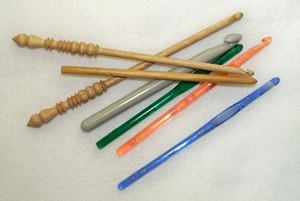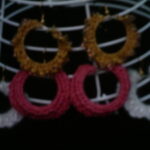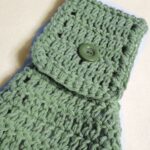Crochet hooks are made out of many different materials, and all have different qualities, both good and bad. Will a wood, metal or plastic crochet hook be best for you?
When deciding what type of crochet hook to buy, read this to determine what size you’ll need based on what project you’ll be working on. Once you know what size hook your project requires, you can decide on what material your crochet hook should be composed of.
Metal Crochet Hooks
The most common crochet hooks are made of metal and many who have been crocheting for years prefer to use the same type of hook they learned to crochet with. You probably remember your mother or grandmother using a metal crochet hook.
The major advantage to working with a metal crochet hook is durability. They are virtually indestructible so unless you have a habit of misplacing them, metal crochet hooks are a good investment. Being durable can also be a disadvantage, though, for someone who suffers from arthritis, as holding the rigid hook for long periods of time can cause pain and stiffness in the fingers and wrist.
I personally don’t like to use metal hooks because of the cold feel to them and also find them too rigid. You can buy spongy covers that slip over the metal that make them more comfortable to use, but that’s an added expense over and above the cost of the hook itself. Since I tend to lose crochet hooks on a regular basis, replacing metal crochet hooks would be costly for me.
Plastic Crochet Hooks
Crochet hooks made of plastic are less expensive than either metal or wood, so if you’re just learning to crochet, they may be the best option for you. You can buy a single crochet hook in the size needed for your first project, or a kit that contains several sizes so you’ll have what’s needed as you continue exploring your craft. I find the plastic hooks easy to work with and like that they’re lightweight and don’t have that cold, industrial feel to them.
One disadvantage to plastic crochet hooks is that they break more easily than either wood or metal. It doesn’t happen often with normal use and they’re inexpensive to replace, but if you leave them where kids could get at them or you’re prone to sitting down without looking, you may want to opt for one of the other types of hooks.
Wood and Bamboo Crochet Hooks
My first experience using wooden hooks was with those carved out of birch by Brittany Needles. They are my favorite crochet hook to work with, but hand carved wooden hooks can be more costly than those made with other materials. I find the wood to be very sturdy, but since it is a natural material, it appears to have a bit more ‘give’ to it, although you can’t actually feel the wood bend (much like a wood floor). This particular brand of crochet hook is longer than most and takes a little getting used to, but many who try them never go back to metal or plastic. Wood hooks are often recommended to those who have arthritis or other hand pain.
Bamboo is one of the newer materials that crochet hooks are being made from, and while I haven’t used one myself, I’ve heard good reports about them. The material feels much like other wooden hooks, so the comfort factor should be equitable. Those I’ve seen are more expensive than plastic or metal hooks, but since they’re available in many craft stores, they’re less costly than hand carved.
If cost isn’t a factor, I would recommend wooden hooks to anyone that doesn’t have a dog that likes to chew. My Rosie didn’t even like to chew dog toys, but for some reason she loved to snatch my Brittany crochet hooks if left unattended. Her teeth marks can still be seen in one of the wooden hooks in the above photo.







